In 2022, Guangzhou Tanke Bio-tech Co., Ltd. published an academic paper titled “Comparison of the Effects of Inorganic or Amino Acid-Chelated Zinc on Mouse Myoblast Growth in vitro and Growth Performance and Carcass Traits in Growing-Finishing Pigs” in the international SCI journal Frontiers in Nutrition in collaboration with the Institute of Subtropical Agriculture, University of Chinese Academy of Sciences, and Central South University of Forestry & Technology.
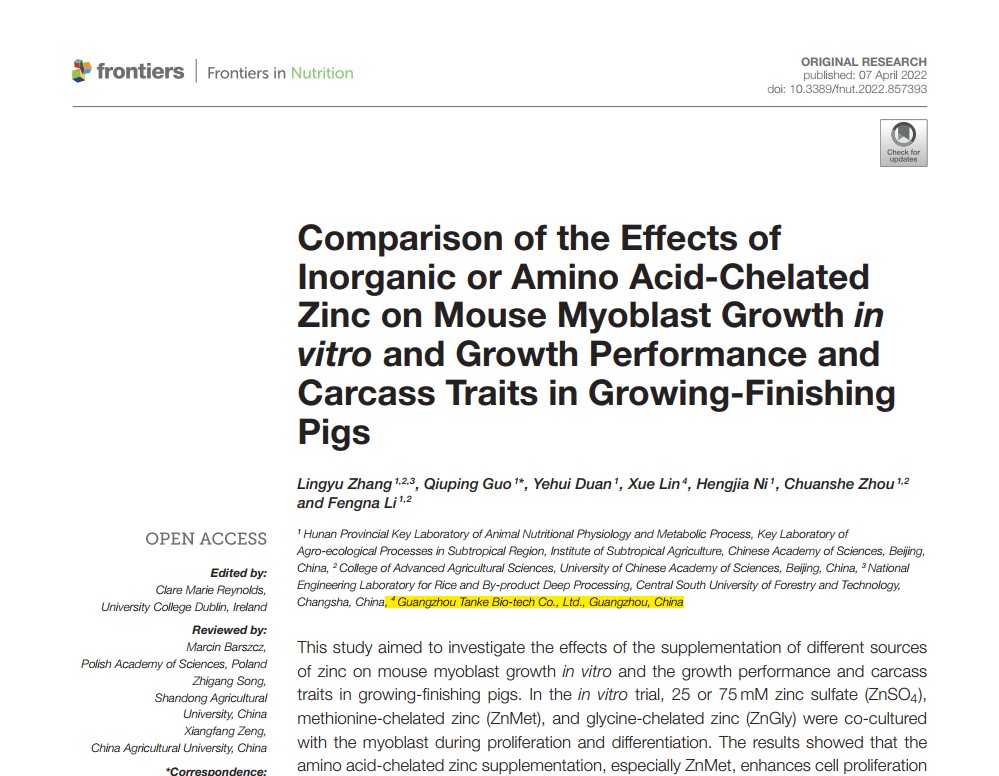
1. Experimentin vitro
In the in vitro trial, 25 or 75mM zinc sulfate (ZnSO4), methionine-chelated zinc (ZnMet), and glycine-chelated zinc (ZnGly) were co-cultured with the myoblast during proliferation and differentiation. The results showed that the amino acid-chelated zinc supplementation, especially ZnMet, enhances cell proliferation and differentiation in mouse myoblast, and regulates the distribution in S and G2/M phases (P < 0.05).
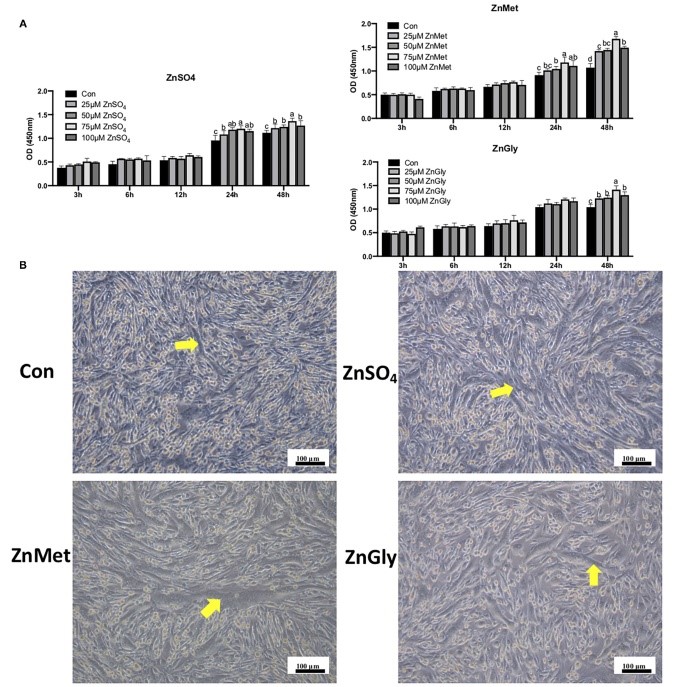
FIGURE 1 | CCK-8 (A) in cell proliferation and morphological responses incell differentiation (B) of C2C12 cell line by adding different zinc sources.
After 8 days of induced differentiation, the myotubes were arranged in a bundle that can be clearly seen in four groups, especially in the ZnMet group. As shown in Figure 1B, the number of myotubes in the control group was significantly less than ZnSO4, ZnMet, and ZnGly groups. Meanwhile, the arrangement of the myotubes in the ZnMet and ZnGly groups were more regular than the ZnSO4 group. It can be seen that ZnMet and ZnGly can significantly promote differentiation and the formation of myotubes in C2C12 cells.
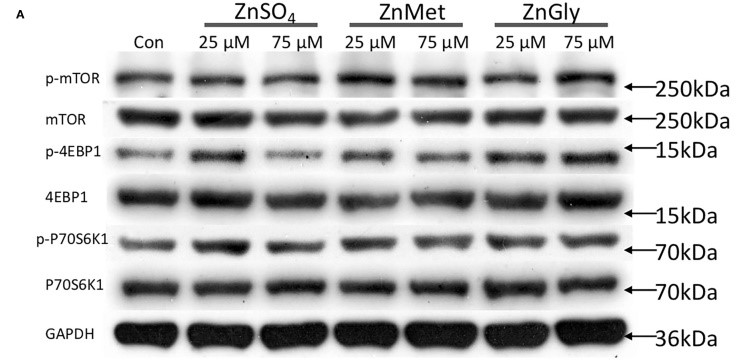

FIGURE2 The protein expression levels of phosphorylated mTOR, 4EBP1, and P70S6K1 wereall up-regulated in myotubes after treatment with 25μM ZnMet (P < 0.05).
2. Experimentin vivo
In the in vivo trial, 27 Duroc ×(Landrace × Large White) pigs with an initial average weight of 31.62 ± 0.36 kg were divided into three groups with nine replicates per treatment. The dietary treatment groups were as follows: (1) ZnSO4 group, basal diet +75mg/kg ZnSO4; (2) ZnMet group, basal diet +75 mg/kg ZnMet; and (3) ZnGly group, basal diet +75 mg/kg ZnGly. The whole trial lasted for 75 days.
The result showed that, ZnMet group had higher final BW and ADG of pigs and lower F/G than other groups, suggesting higher bioavailability of ZnMet. In terms of carcass traits, ZnMet group also showed a relatively higher carcass weight, dressing percentage, and loin eye area, showing that ZnMet supplementation may lead to higher energy metabolism, protein synthesis, and muscle mass in pigs.
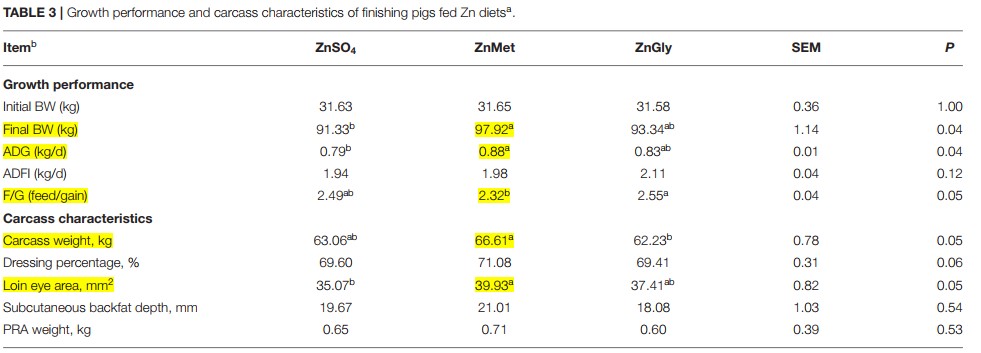
Besides, ZnMet group andZnGly group also had lower serum TP (P<0.05), and ZnMet increased serum ALP (P<0.05).<>

Supplementation of ZnMet significantly increased the content of Zn and Fe in muscle, liver and serum, indicating that the addition of ZnMet can improve the absorption and utilization of micronutrients.

In conclusion, these findings provided new insights into the molecular and physiological mechanisms by which the amino acid-chelated zinc, especially ZnMet, improves myoblast growth while increasing bioavailability. Compared to the inorganic zinc form, the dietary supplementation of 75 mg/kg amino acid-chelated zinc could improve the growth performance and carcass traits of growing-finishing pigs.
The ZnMet and ZnGly in the present study were supplied by Guangzhou Tanke Bio-tech Co., Ltd. Tanke’s QILI®-Zn is awarded as Guandong Top Brand Product, is a new generation of organic trace mineral with high bio-availability, stability and safety. It efficiently supplies zinc to various animal, while minimizing the reaction of zinc ion to vitamins and other active ingredients in feed, and improves the utilization of feed.
QILI®-Zn:
Product Appearance |
Microcosmic Appearance |
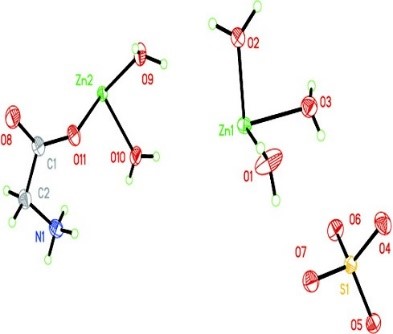
Chemical Structure
 020-38859025
020-38859025

















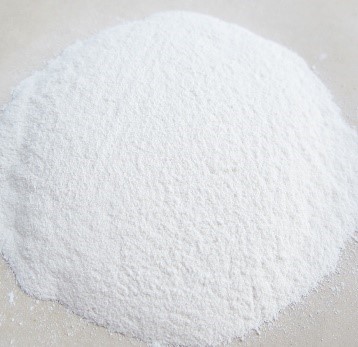
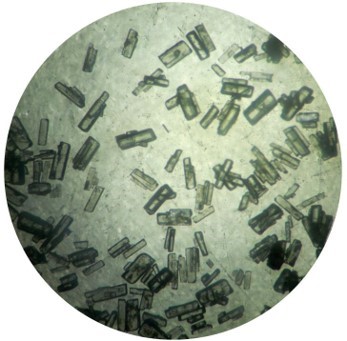


















 客服一
客服一


